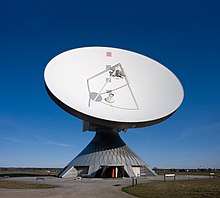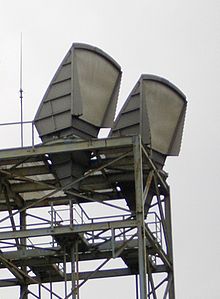A microwave antenna is a physical transmission device used to broadcast microwave transmissions between two or more locations.[1] In addition to broadcasting, antennas are also used in radar, radio astronomy and electronic warfare.



Microwave frequency bands
edit| C band | 4 to 8 GHz | 3.75 cm to 7.5 cm | 4 GHz, 6 GHz |
| X band | 8 to 12 GHz | 25 mm to 37.5 mm | 10 GHz, 11 GHz |
| Ku band | 12 to 18 GHz | 16.7 mm to 25 mm | 12 GHz, 18 GHz |
| K band | 18 to 26.5 GHz | 11.3 mm to 16.7 mm | 18 GHz |
| Ka band | 26.5 to 40 GHz | 5.0 mm to 11.3 mm | 23 GHz, 31 GHz |
| Q band | 33 to 50 GHz | 6.0 mm to 9.0 mm | 38 GHz |
| W band | 75 to 110 GHz | 2.7 mm to 4.0 mm | 70 GHz, 80 GHz, 90 GHz |
Uses
edit- One-way (e.g. television broadcasting) and two-way telecommunication using communications satellites
- Terrestrial microwave relay links in telecommunications networks including backbone or backhaul carriers in cellular networks linking BTS-BSC and BSC-MSC.
- Radar
- Radio astronomy
- Communications intelligence
- Electronic warfare
Antenna types
editReflector antennas
editA parabolic antenna is an antenna that uses a parabolic reflector, a curved surface with the cross-sectional shape of a parabola, to direct the radio waves. These devices range anywhere from 6" to more than 12' diameter depending on application and use.
Horn antennas
editA horn antenna or microwave horn is an antenna that consists of a flaring metal waveguide shaped like a horn to direct radio waves in a beam. Horns are widely used as antennas at UHF and microwave frequencies, above 300 MHz.[3]
Lens antennas
editA lens antenna uses a lens to direct or collect microwave radiation.
Array antennas
editAn array antenna is a high gain antenna consisting of an array of smaller antenna elements.
Leaky wave antenna
editA leaky wave antenna uses a leaking transmission line to obtain radiation.
Spiral antenna
editA spiral antenna, configured in the shape of a spiral, serves as a radio frequency antenna. It can function independently or as a feeder for satellite communication reflector antennas. It ensures excellent impedance matching and radiation pattern performance across the entire operating frequency band.
References
edit- ^ Balanis, Constantine. Antenna theory; analysis and design (3rd ed.).
- ^ "Point-to-Point Microwave". 22 February 2016.
- ^ Bevilaqua, Peter (2009). "Horn antenna - Intro". Antenna-theory.com website. Retrieved 2010-11-11.